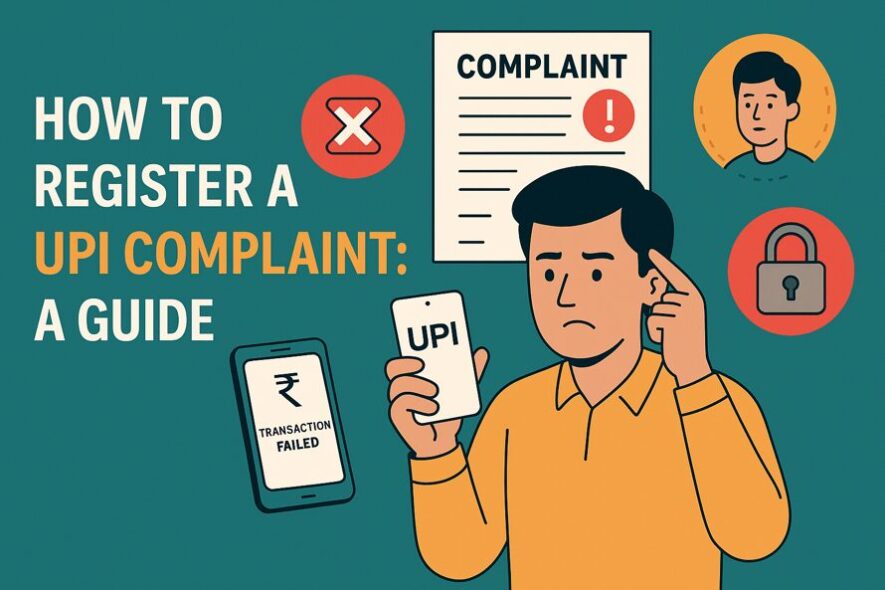
Understanding UPI and Common Issues Faced
UPI, or Unified Payments Interface, has emerged as the most widely used digital payment system. It links multiple bank accounts, allows transfers through mobile apps, and runs 24/7. From tea stalls to shopping malls, UPI powers billions of monthly transactions. But despite its convenience, things can go wrong. Understanding the common issues makes it easier to raise the right complaint and get your money back without unnecessary stress.
Failed Transactions
This is the number one issue users face. You send money, the app shows “failed,” but the amount is deducted from your bank. The receiver confirms they never got it, and you’re stuck in limbo. For example, imagine paying ₹750 for groceries at Big Bazaar. The UPI app flashes “transaction failed,” but your bank balance drops by ₹750. This is technically a “debit without credit” error. Usually, such cases are reversed automatically in 2–3 working days, but sometimes they require you to file a formal complaint.
Wrong Credit/Debit
Typing the wrong UPI ID or mobile number can redirect money to someone else. Unlike failed transactions, this money doesn’t bounce back automatically. For instance, instead of sending ₹1,000 to your landlord “rahul@upi,” you accidentally send it to “rahul123@upi.” Now that the money has been transferred to another account, you must file a complaint to recover it. Duplicate debits are another version of this, where one payment is deducted twice.
Unauthorized Transactions
Fraud cases are rising as scammers trick users into sharing UPI PINs or approving “collect requests.” For example, someone pretending to be from your bank may send a request asking you to “accept to verify account.” The moment you approve, money is siphoned out. These require immediate reporting because RBI guidelines state that users bear zero liability if they report fraud within 3 days.
Delay in Fund Transfer
UPI is designed for instant payments, but sometimes technical glitches delay settlements. You may see the amount deducted, but the “processing” status stays for hours. For example, you transfer ₹5,000 to a family member, and the amount leaves your account but doesn’t reach them for the next three hours. In such cases, a complaint helps trace whether the money is stuck with your bank, the receiver’s bank, or the NPCI switch.
Types of UPI Complaints and When to File Them
Every UPI complaint falls into a specific bucket. Filing under the right category ensures faster resolution.
Technical Errors vs. Fraudulent Activity
- Technical errors include failed payments, wrong debits, and delays. These are system glitches and usually get resolved in a few days once you file the complaint.
- Fraudulent activity includes scams, phishing, or unauthorized debits. These require urgent escalation to the bank and NPCI, followed by RBI if unresolved. Here, timelines are shorter, and liability depends on how quickly you report.
Complaints Against Banks or Third-Party Apps
- If your bank (payer or receiver bank) caused the problem, you must log the complaint with them.
- If your UPI app (PhonePe, GPay, Paytm, etc.) caused it, raise the issue inside the app. The app will forward it to your bank if needed.
For example, if you pay via Google Pay and the money is deducted but not credited, your first step is to raise the issue in Google Pay. If not resolved, you contact your bank’s customer service.
Timelines for Complaint Resolution
- Failed transactions: usually T+1 to T+3 working days.
- Unauthorized transactions: must be reported immediately, ideally within 24 hours. RBI mandates that banks refund within 10 working days once liability is established.
- Wrong credits: can take longer, sometimes 7–30 days, because it involves recovering money from another user.
Step-by-Step Guide to Register a UPI Complaint
Through UPI App (PhonePe, GPay, Paytm, BHIM, etc.)
Every major UPI app has an in-built dispute resolution option. Here’s the step-by-step process:
- Open the app and go to your transaction history.
- Select the problematic transaction (failed, duplicate, or unauthorized).
- Tap “Raise Complaint” or “Report Issue.”
- Choose the correct problem type (failed debit, money not credited, fraud, etc.).
- Fill in details like transaction ID, date, amount, and UTR number.
- Submit the request.
Example: In PhonePe, tap “History,” pick the transaction, and click “Report a Problem.” It creates a support ticket instantly, and you get updates on the app.
Using the Bank’s Customer Service
If the app route doesn’t work:
- Call your bank’s toll-free number or visit the branch.
- Share the UTR number (Unique Transaction Reference) from your SMS or app.
- Ask them to log a formal complaint under the UPI Dispute Management System (UDMS).
- Collect the complaint reference number for follow-up.
Banks usually resolve failed transactions quickly because they are traceable in NPCI logs.
Through NPCI’s Online Dispute Resolution System
NPCI operates the UPI network and provides an ODR (Online Dispute Resolution) portal. Steps:
- Visit npci.org.in.
- Go to “Dispute Redressal.”
- Enter transaction details (UTR, date, amount, bank name).
- Submit your complaint.
NPCI forwards it to the bank or app and ensures it gets tracked centrally.
Via RBI Ombudsman (in unresolved cases)
If both app and bank fail, and 30 days have passed, escalate to RBI’s Ombudsman through the Complaint Management System (CMS) portal. Upload screenshots, bank replies, and complaint IDs. The RBI investigates independently and instructs the bank to resolve the matter.
How to Track the Status of a UPI Complaint
In-App Tracking
UPI apps update you in real time. For example, Paytm shows “Refund Under Process” and later “Refund Completed.” This way, you don’t need to call customer care.
Using Bank Reference Number or UTR
Your UTR number is the master key. It’s a 12-digit code that identifies the transaction in NPCI’s system. Share it with your bank, and they can instantly pull the status. Example: If your UTR is 312456789123, your bank can check whether the money is stuck with them or the receiver’s bank.
Escalation Process if Delayed
- If no update in 3 days, escalate to the bank’s Nodal Officer (details are on the bank’s website).
- If no resolution after 30 days, file with the RBI CMS.
Tips for Faster Complaint Resolution
Keep Transaction IDs Handy
Always copy or screenshot the UTR number. Without it, complaints may drag on.
Report Immediately
Fraud cases require reporting within 24 hours. For technical issues, the sooner you report, the faster the system can trace the error.
Use Official Channels Only
Avoid fake customer care numbers from Google search. Scammers often impersonate banks. Stick to app support, bank helplines, or RBI CMS.
Your Rights as a UPI User Under RBI Guidelines
RBI protects UPI users with strict rules:
- Zero liability if fraud is reported within 3 days.
- Limited liability if reported within 4–7 days.
- Full liability if reported after 7 days.
- Refunds for failed or duplicate transactions must be processed by the T+1 working day.
- Every bank must run 24/7 complaint support for UPI.
Conclusion
UPI has simplified life for millions, but problems can still arise, such as failed transfers, fraud, or delays. The process to register a UPI complaint is structured: start with your app, escalate to the bank, move to NPCI if needed, and finally, the RBI if nothing works. Always act quickly, keep UTR numbers safe, and know your rights. Complaints may feel stressful, but with the proper steps, you can ensure your money is safe and refunded on time.
FAQs:
How long does it take to resolve a UPI complaint?
Most failed transactions are reversed in T+1 to T+3 working days. Fraud or wrong credit cases can take longer, sometimes up to 30 days, depending on the investigation.
What should I do if my UPI transaction fails, but money is deducted?
First, check your transaction status in the app. If it shows “failed” but the debit remains, raise a complaint through the UPI app immediately. Keep the UTR number handy for follow-up with your bank.
Can I get a refund for an incorrect UPI transfer?
Yes, but it depends on the recipient’s bank and cooperation. You must file a complaint with your bank, which will reach out to the beneficiary bank through NPCI. Refunds usually take longer than failed transactions.
How do I file a complaint with NPCI?
Go to the NPCI Dispute Redressal page on npci.org.in, enter your UTR, bank details, and issue type, and submit the complaint. NPCI forwards it to the concerned bank/app for resolution.
What if my UPI complaint is not resolved by the bank?
If unresolved after 30 days, you can escalate to the RBI Ombudsman through the CMS portal. Upload screenshots of your complaint and all correspondence for RBI to intervene.
Is there a helpline number for UPI issues?
Yes. NPCI runs a 24×7 helpline at 1800-120-1740. You can also use your bank’s toll-free number or the in-app support section of your UPI app for direct assistance.




